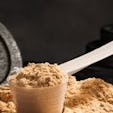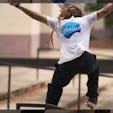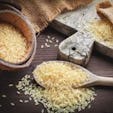We all have one muscle that we think is the true mark of a great physique. Many will say it’s six-pack abs, while others will argue it’s a big set of traps. There’s another muscle group, however, that’s not often called out by name or brought up in conversation, but, when you point to it, everyone seems to agree that it’s common to the best bodies in the world. It also happens to be the key to shoulder health and upper-body power¦ Give up? It’s the serratus anterior.
To the untrained eye, the serratus anterior muscle may appear to be an extension of the obliques, but it’s a muscle all its own, and its function is very different. Together with its twin on the back side of your body, the serratus posterior, the serratus muscles anchor the shoulders, allow you to breathe, and, when well-developed on a lean physique, show the world you’re a finely-tuned athlete.
We broke out our anatomy books and talked to an expert to bring you the definitive guide to training the serratus muscles for aesthetics, performance, and injury prevention.
What Are Your Serratus Muscles and Why Train Them?
There are three sets of serratus muscles. The best known of the group is the serratus anterior (SA)—it’s those finger-like muscles under your pec that pop out when you raise your arm overhead (that is, if you’re lean enough to see them). The other, lesser-known two are the serratus posterior (SP) superior and inferior. As the name implies, they lie on the back of your torso.
Serratus Anterior (SA)
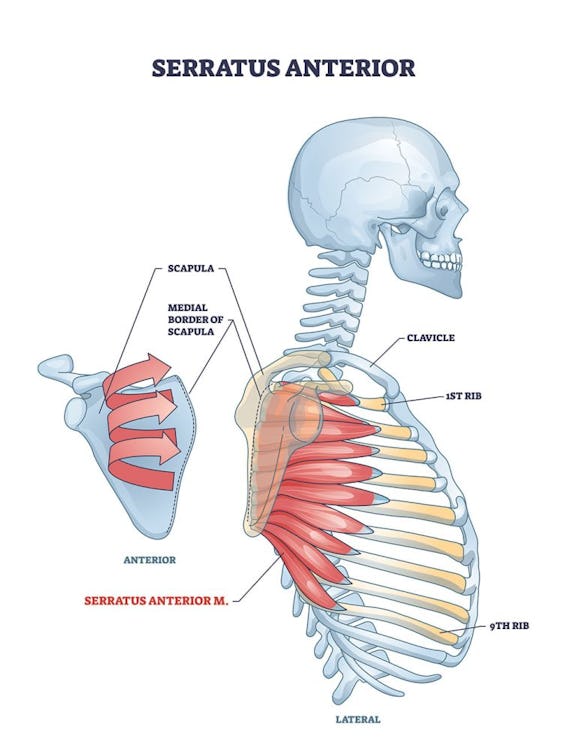
The SA muscle originates at the first to ninth ribs and inserts on the inner side of the front of the scapula (shoulder blade), close to the spine. It has a fan shape with serrated, sawtooth-like attachments on the ribs, which gives it its name. The SA works to protract the shoulder blade—that is, roll your shoulder forward when you reach your arm in front of you—as well as rotate the shoulder blade upward when you raise your arm overhead, stabilize the scapula, and lift the ribs during inhalation. Since it works to pull the shoulder forward when you’re throwing a punch, the SA has been nicknamed the boxer’s muscle.
Serratus Posterior (SP)
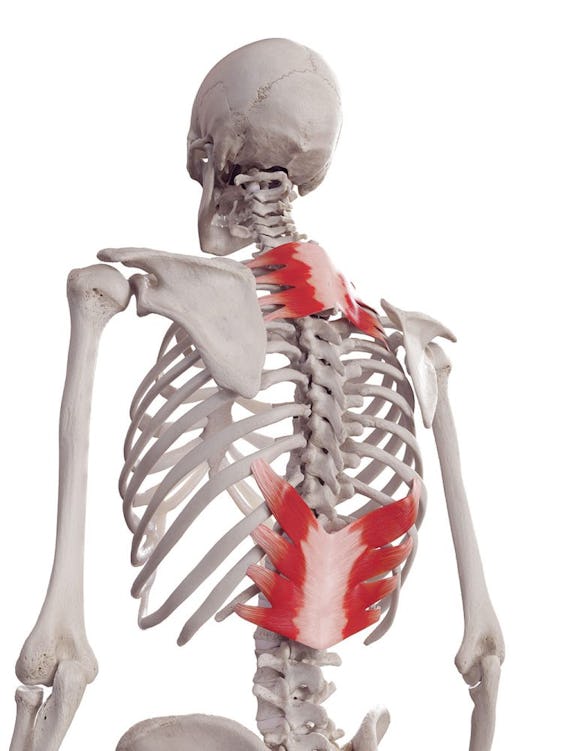
The SP consists of two distinct wing-shaped muscles that mirror each other on the back of your torso. The SP superior lies between your shoulder blades, under your trapezius, on the upper back. It originates on the ligaments of the upper spine, and the cervical and thoracic vertebrae, and it inserts on ribs two through five. Meanwhile, the SP inferior rests on your lower back, under your lats. It starts on the ligaments of the lower spine and the lumbar and thoracic vertebrae and reaches upward to insert on ribs nine through 12.
Scientists aren’t certain they know all the actions the SP can perform, but it’s pretty clear that the superior portion helps raise the upper ribs when you breathe in, while the inferior draws the lower ribs downward and backward when you breathe out.
Training the SA and SP
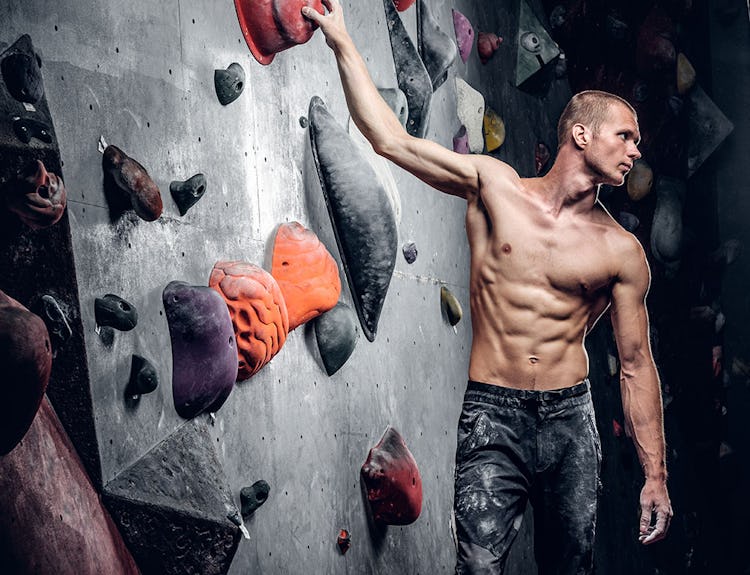
The serratus anterior plays a crucial role in the shoulder’s health and durability. Because it helps control movement of the shoulder blade, and even anchors the scapula to the rib cage, it’s vital for performing any kind of press, push, throwing action, or upper-body martial arts strike. “Think of your body as a sailboat and your upper arm as the sail,” says Alexander Friel, DC, a care provider at Airrosti clinic in Dallas, TX. “In order to get the boat moving, you have to hoist the sail. Your serratus anterior is the rope that lifts the sail.”
When someone’s SA is not functioning properly, it is very easy to see. The shoulder blade will not slide smoothly forward around the ribs. It will actually flare off the back, separating from the rib cage—a condition called scapular winging, which can result in shoulder injury.
The serratus anterior can be trained with a number of pushing and pressing exercises—basically, anything that involves the shoulder blades, says Friel. The serratus posterior muscles, on the other hand, really can’t be isolated and trained directly. Since they work when you breathe—particularly when you inhale and exhale forcefully—you can rest assured that they’re getting trained when you perform other exercises and activities that make you breathe hard. Furthermore, unlike the SA, the SP are invisible from the outside, so they don’t contribute to the aesthetics of your physique.
How To Stretch The Serratus Muscles
Activities that involve repetitive overhead shoulder motions can bring tightness and injury to the serratus anterior. These include swimming and tennis, as well as weight training—particularly, lifting heavy on bench and overhead presses. Poor posture (slouching) can also lead to tight muscles around the shoulders and ribs. The following stretches may provide some relief.
Serratus Anterior
SA Stretch On Bench
[See 0:28 in the video above]
Friel recommends this stretch, which you’ll also likely feel in your lats and triceps.
Step 1. Hold a yoga block or light dumbbell with both hands, and kneel on the floor perpendicular to a bench. Bend your elbows 90 degrees and rest them on the bench; bend your hips and knees 90 degrees, and brace your core.
Step 2. Gently press your chest toward the floor while you bend your elbows back toward you, stretching your serratus. Hold the stretch 15–30 seconds.
That’s one set. Perform 3 sets.
The late Chris Jarmey, D.S., author of The Concise Book of Muscles, a comprehensive guide to anatomy, now in its fourth edition, also suggests stretching one side of the serratus at a time.
Chair Stretch
[See 0:57 in the video]
Step 1. Sit in a chair with a back support and turn your body to the right 90 degrees. Let your arm hang over the back of the chair, and grasp the bottom of the chair for stability.
Step 2. Gently turn away from the back of the chair until you feel a stretch in your rib cage. Hold 30 seconds.
Alternate sides until you’ve stretched both for 3 rounds.
In addition to the above, stretches that target the pec and deltoid may stretch the SA involuntarily as well, so include them in any program with the goal of lengthening the serratus anterior.
Serratus Posterior
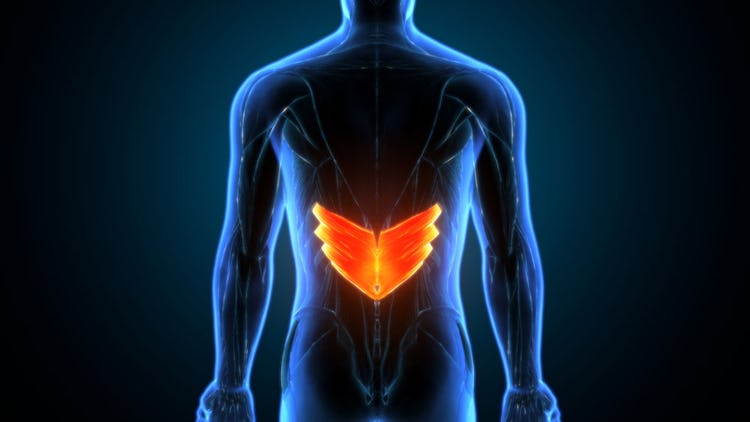
Dr. Friel calls the serratus posterior a “small, controversial muscle,” because its full purpose isn’t certain, and it can’t be targeted and isolated like other muscles. However, the following stretch will help to lengthen it, as well as the muscles in your hips and the back side of your body.
Kettlebell SP Stretch
[See 1:21 in the video]
Step 1. Place two heavy kettlebells on the floor, shoulder-width distance apart. (Or, elevate some dumbbells on a mat or blocks so they’re a few inches above the floor.)
Step 2. Stand behind the kettlebells with feet hip-width apart and hinge at the hips, driving your butt back, as if doing a Romanian deadlift or bent-over row. Continue until your torso is nearly parallel to the floor, or as close as is needed for you to be able to reach the kettlebells. Keep a long spine so that your lower back is flat.
Step 3. When you can reach the kettlebells, grasp the handles and hold the position. You should feel a stretch on your back between your shoulder blades—the serratus posterior will be stretching along with your other upper back muscles. Hold the position for 30 seconds, breathing slowly and deeply to increase the stretch. That’s one set.
Perform 3 sets.
3 Serratus Anterior Exercises
Friel suggests the following to build up your SA.
1. Pushup Plus
[See 2:12 in the video]
Step 1. Get into a pushup position on the floor with hands slightly wider than shoulder width. Think “long spine,” so your body forms a straight line from your head to your heels. Draw your ribs down, and tuck your pelvis slightly so that it’s perpendicular to the floor. Brace your core.
Step 2. Keeping your elbows locked, actively lower your upper body toward the floor by squeezing your shoulder blades together. The range of motion is small.
Step 3. Drive your hands into the floor like you’re doing a pushup, but keep your arms straight, and move only at the shoulders. Think about spreading your shoulder blades apart so your upper back moves toward the ceiling. Another cue is to think about pushing the floor away from you, rather than the other way around. Go as high as you can without losing your straight body position, and hold the top position for a second. That’s one rep.
Perform sets of 8–15 reps.
If the basic pushup plus is too easy, wrap an elastic exercise band around your upper back for extra resistance. If it’s too hard, you can perform the same movement on your knees, or on an elevated surface, such as a countertop.
2. Pullup Plus
[See 3:15 in the video]
Step 1. Hang from a pullup bar with hands just outside shoulder width and palms facing forward. Draw your ribs down and tuck your tailbone so that your pelvis is level with the floor. Brace your core.
Step 2. Drive your shoulder blades down and together, so that your body lifts higher toward the bar, but keep your arms straight so that the movement is only at the shoulders.
Step 3. Lower your body back down, allowing your serratus to stretch at the bottom, but don’t relax completely. Perform as many reps as possible.
3. Farmer’s Walk
[See 3:46 in the video]
Step 1. Pick up a pair of heavy dumbbells and draw your shoulder blades back and down. Walk briskly for as far as you can while Keep good posture—chest proud, standing tall and straight.
1 Serratus Posterior Exercise
[See 4:00 in the video]
The best way to work the SP is simply by maintaining perfect posture and breathing. “Keep your pelvis tucked under you,” says Friel, which means it will be level with the floor. “Stand up and squeeze your glutes and abs—you’ll feel your pelvis stabilize underneath you.” At the same time, pretend you have a fishing line attached to your sternum (your breastbone) that’s pulling straight upward. Standing tall with a level pelvis is perfect posture.
Practice breathing in this position. Do a set of 20–25 deep breaths, drawing the air into your abdomen. This means expanding your belly 360 degrees, rather than letting your shoulders rise and fall. Take 8–10 seconds for each inhale and 6–8 seconds on every exhale.
Great Complementary Exercises For Your Workout
Remember that any exercise that has the shoulder blades moving is going to activate your serratus anterior to a large degree. The following moves not only hit the SA hard but they train many other muscles as well, and are particularly popular for physique development. The ab rollout doubles as a core/six-pack exercise, the pullover as a chest and back hit, and the overhead press as a shoulder, tricep, and overall strength-builder.
Ab Rollout
[See 4:35 in the video]
Step 1. Kneel on the floor and hold an ab wheel beneath your shoulders. Draw your ribs down, tuck your tailbone, and brace your core, so that your head, spine, and pelvis form a straight line.
Step 2. Roll the wheel forward until you feel you’re about to lose tension in your core and your hips might sag. Roll yourself back to the starting position.
Dumbbell Pullover
[See 4:56 in the video]
Step 1. Hold a dumbbell by one of its bell ends and lie back flat on a bench. Press the dumbbell up and hold it directly over your chest with your elbows pointing out to the sides. Tuck your pelvis under so that your lower back is flat on the bench and brace your core.
Step 2. Keeping your elbows as straight as possible, lower your arms back and behind you until you feel a strong stretch in your chest.
Step 3. Pull the weight back up and over your chest.
Performing the movement with bands or a cable would be even more effective than using a dumbbell or barbell, as the band/cable tension would force the pecs to work harder as they get closer to the chest (which is where the resistance drops off with free weights).
Kettlebell One-Arm Overhead Press
[See 5:22 in the video]
Step 1. Stand tall, holding the kettlebell in one hand at shoulder level. Root your feet into the floor as if you were preparing for someone to push you. Draw your shoulder blades down and back—think, “proud chest”— pull your ribs down, and brace your core. Take a deep breath into your belly.
Step 2. Exhale as you press the weight overhead with your forearm vertical. Your elbow will naturally move away from your side and the press will feel like an “around the world” motion—that’s OK. Note that your chin should be pulled back so that weight has no trouble clearing it.
Step 3. To lower the kettlebell, pull it back down into position—as if you were performing a pullup. Complete all your reps on that side, and then repeat on the other side.
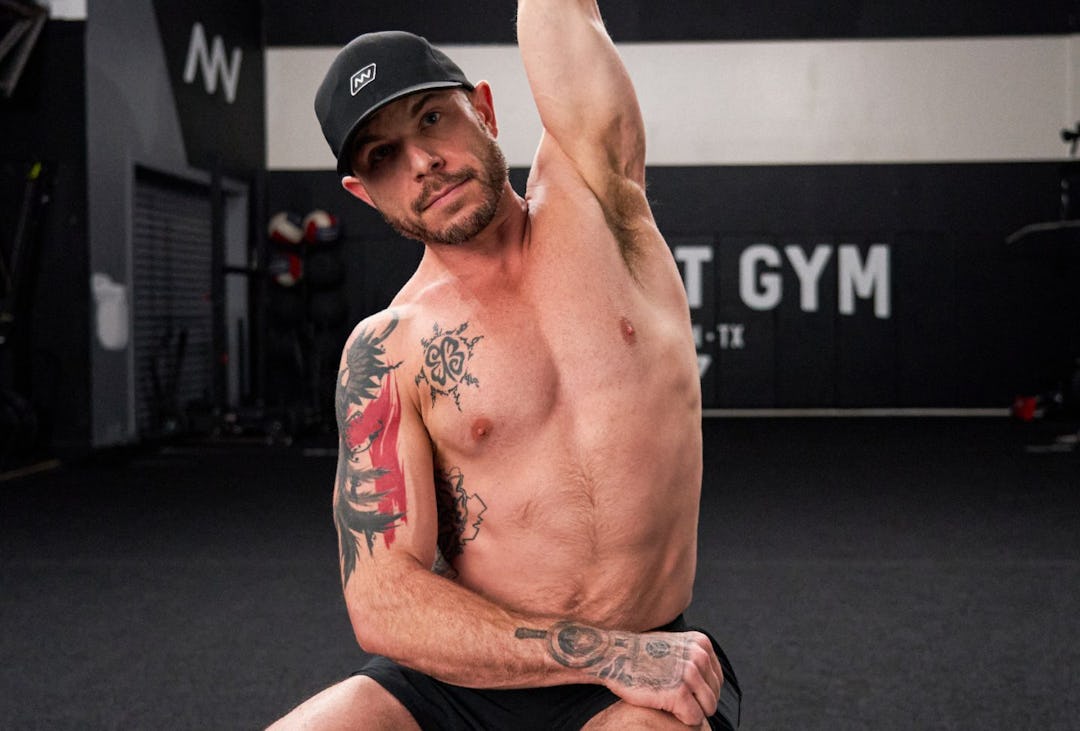
)

